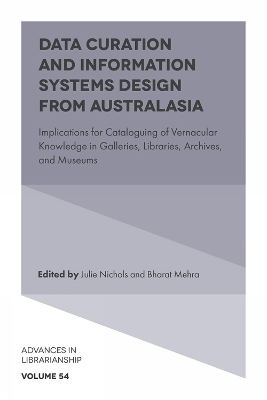
Data Curation and Information Systems Design from Australasia
Emerald Publishing Limited (Verlag)
978-1-80455-615-3 (ISBN)
The need for decolonizing cultural institutions and their mismanagement practices in galleries, libraries, archives, and museums, of First Nations peoples’ materials and knowledge has been widely recognised. However, this has not translated into an information systems design, nor a complementary solution representing an alternative world view. Instead, the entrenched legacy of the neoliberal sector’s curatorial and archival practices remains intact, and their authority stays unquestioned. This edited book’s unique viewpoint is its exploration of projects that investigate innovative data curation strategies through the thematics of visual representation of infrastructure, and bodies of knowledge.
Authors from Indigenous and non-Indigenous backgrounds underpin their chapters with a social justice approach to investigations around different knowledge systems. They powerfully challenge entrenched assumptions of knowledge capture and dissemination of the western academy. An emphasis on visualisations of cultural heritage materials across a variety of case studies using technologies that range from augmented and virtual realities to mixed reality aims to raise questions for debate in the way Indigenous data is collected, managed, curated, governed, and represented and by whom.
Julie Nichols is a Senior Lecturer in the architecture program at the University of South Australia. Julie leads the Vernacular Knowledge Research Group [VKRG]. Bharat Mehra is EBSCO Endowed Chair in Social Justice and Professor in the School of Library and Information Studies at the University of Alabama.
POEM; Yali Leanne Windl
PREFACE; Kirsten Thorpe
INTRODUCTION: Co-design & Social Justice Opportunities in Information System Design; Julie Nichols and Bharat Mehra
PART 1: INFRASTRUCTURE [SECTIONAL SYNOPSIS]; Julie Nichols and Bharat Mehra
Chapter 1. The Ethics and Cultural Sensitivities of Data Management: Some Considerations; Anna Leditschke, Julie Nichols, Karl Farrow, and Quenten Agius
Chapter 2. Enhanced Material Management: Application of Natural Language Processing and Rule Based Modelling for Simplifying Storage Requirements in a Museum; Georg Grossmann, Alice Beale, Harkaran Singh, Ben Smith, and Julie Nichols
Chapter 3. Reflections from the Field: Country in a Plastic Bag; Stephen Nova
Chapter 4. Galleries, Libraries, Archives, Museums [GLAM]-focused Games and Gamification; Erik Champion and Susannah Emery
PART 2: BODIES OF KNOWLEDGE [SECTIONAL SYNOPSIS]; Julie Nichols and Bharat Mehra
Chapter 5. Entwined Vernaculars: Heritages of Tolerances, Reconciliation and Resistance; Julie Nichols and Quenten Agius
Chapter 6. Working to Improve the Fire Exhibit of the Australian Aboriginal Cultures Gallery (AACG); Jared Thomas
Chapter 7. An Exploration of Digital Representation of Australian Aboriginal Art in Museums for Immersive Engagement; Rui Zhang and Fanke Peng
Chapter 8. Clapsticks: Investigating Curatorial Opportunities; Eloise Labaz, Julie Nichols, Rebecca Agius, and Quenten Agius
Chapter 9. Alternate Worldviews: Implications for Design, Architecture, and Cultural Records; Subook Samridhi and Yali Leanne Windl
Chapter 10. More Than an Exhibition: Finding Voice, Tiati (truth) and New Perspectives; Julia Garnaut, Lynette Crocker, Jeffrey Newchurch, and Merle Simpson
PART 3: BODIES OF EXPERIENCE [SECTIONAL SYNOPSIS]; Julie Nichols and Bharat Mehra
Chapter 11. Yarning Journeys: Ngadjuri Perspectives on Cultural Heritage; Julie Nichols, Jeffrey Newchurch, Robert Rigney, Bonita Sansbury, and Tinesha Miller
Chapter 12. The Significance of Country: Ngadjuri Voices and Cultural Heritage; Julie Nichols, Lynette Newchurch, Rebecca Agius, Ann Newchurch, and David Weetra
Chapter 13. Agency and Authority in Intangible Cultural Heritage; Brye Marshall and Julie Nichols
Chapter 14. Aboriginal Cultural Heritage in South Australia: Where to Next?; Deanne Hanchant-Nichols
PART 4. REPRESENTATION [SECTIONAL SYNOPSIS]; Julie Nichols and Bharat Mehra
Chapter 15. ‘Inter-sites of Knowledge’: Jules Janssen’s Nineteenth-century Astronomical Apparatus and a Contemporary Moving Image System; Deirdre Feeney
Chapter 16. AR Storytelling for the Galleries, Libraries, Archives, Museum [GLAM] Sector: A case Study with the South Australian Museum Fire Exhibit and Megafauna Displays; Ben Stubbs
Chapter 17. Can the Transdisciplinary Co-creation of Extended Reality Experience (XR) Artworks Help Decolonise the GLAM Sector?; Mairi Gunn, Irene Hancy, and Tanya Remana
Chapter 18. Beyond the Inanimate Line: Expanding Narratives of Drawings in Contemporary Creative Practice and Architectural Education; Katica Pedisic
CONCLUSION; Julie Nichols and Bharat Mehra
| Erscheinungsdatum | 17.01.2024 |
|---|---|
| Reihe/Serie | Advances in Librarianship |
| Verlagsort | Bingley |
| Sprache | englisch |
| Maße | 152 x 229 mm |
| Gewicht | 583 g |
| Themenwelt | Sozialwissenschaften ► Ethnologie |
| Sozialwissenschaften ► Kommunikation / Medien ► Buchhandel / Bibliothekswesen | |
| Sozialwissenschaften ► Soziologie | |
| ISBN-10 | 1-80455-615-7 / 1804556157 |
| ISBN-13 | 978-1-80455-615-3 / 9781804556153 |
| Zustand | Neuware |
| Haben Sie eine Frage zum Produkt? |
aus dem Bereich


